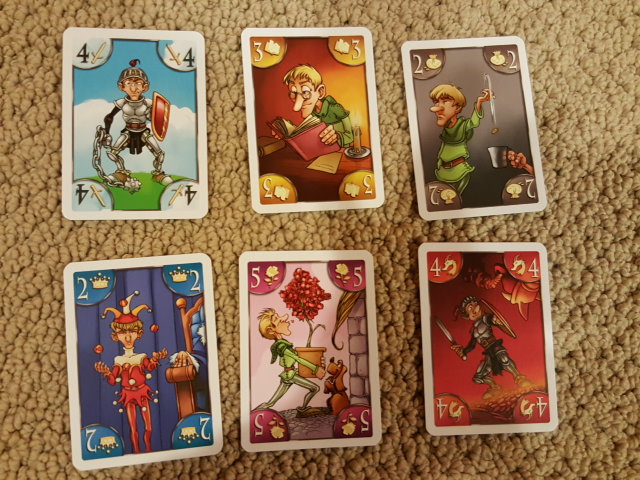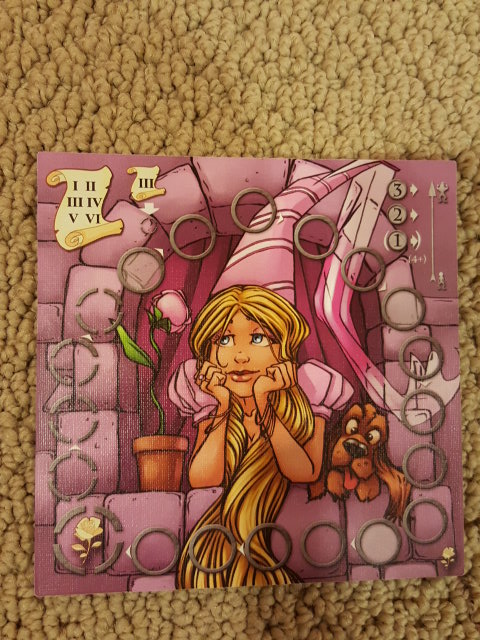Medieval Academy
- Designer: Nicolas Poncin
- Publisher: IELLO / Blue Cocker Games
- Players: 2-5
- Ages: 8+
- Time: 30 minutes
- Times Played: 3, with review copy provided by IELLO
Twelve years ago, when I was still just starting to go to Essen, part of the draw to making the annual pilgrimage was to get my hands on some of the awesome small print run games that you could only get while there. If you remember those days, you’d be with me scouring the second floor of hall 9 (the mysterious 9.1), buying every Japanese game you could find (because they were all one-time-only print runs of 500 copies or less) or digging through all of hall 6 to find the three teeny booths that happened to be selling games instead of leather bodices and chainmail…
Flash forward to 2015… Now, things are a bit different. There are still plenty of hidden treasures to be had at Essen, but most of them – given enough time – will rise to the surface with either a reprint or larger distribution when the title is bought up. Medieval Academy is an example of that new class of games. I remember seeing the title while walking through the press event on the Wednesday of last year’s Essen, but I didn’t have to get a demo. I didn’t know anything about it, but the art was cool… later I found out that my good friend Piero was the artist, and I did write it down on my list of games to go check out by the end of the weekend. As anyone who has been to Essen can attest to – it’s hard to keep to your plans! There are just so many games to look at, and something will get missed along the way. I never did make it back to look at Medieval Academy, and only later did I discover that many people who brought it home ended up loving it! I was trying to figure out how to import a copy from France, but then at GenCon 2015, it was announced that IELLO was going to do a reprint to bring the game to the larger gaming market – and that’s how I got my second chance at this game. (In the same box, I received a second chance to play Dungeon of Mandom, a fun Japanese game that is also being reprinted by IELLO as Welcome to the Dungeon.)
In Medieval Academy, there are 7 scoring boards to track your progress in the following categories: Gallantry, Jousts, Tournaments, Education, King’s Service, Quests and Charity. Each of these boards scores at different times in the game, awarding positive or negative VPs depending on your relative standing on the track at the times of scoring. These boards are laid out in the center of the table, and each player puts their colored marker on the first space of each track.
In each of the six rounds of the game, players are dealt a hand of 5 cards. The deck of cards includes numbered cards (ranging from 2 to 5) in six suits, one for each scoring board with the exception that Jousts and Tournaments share a suit.
Once players have a hand, they select a card, place that card facedown and then pass the remainder of their hand in the direction noted on the round chart. With their new hand, they again select a card and pass the rest. This continues until all players have 5 facedown cards in front of them.
In the next phase, players take turns playing cards from their hand, one at a time. As a card is played, you move your marker up on the matching colored scoring card a number of spaces equal to the value of the card. If you land on a space with another marker, you simply place your marker on top. Later in the scoring phase, a marker on top of a stack is said to be of a higher rank that those beneath it. Again, note that the Jousts and Tournament boards share a color. If you play a blue card, you have to choose which one of the tracks to move up on – your play cannot be split amongst the two tracks. Play continues around the board until all players have played 4 of their 5 cards. The fifth card is never played; it is simply discarded.
Next, you check each board to see if it scores. In the upper left of each board, there is a scroll which lists the rounds in which that particular board will score. Some boards will score every round while others may only score once in the game. If the current round is listed on the scroll, you resolve the scoring card.
The Gallantry board is always scored first (and in every round). The relative rank of the players is determined, and then the third place player is able to move any one disc on any board (including the Gallantry board) up by one space. The second place player then moves any disc two spaces and then the first placed player on the Gallantry board moves any single disc three spaces forward.
The other game boards can be scored in any order. If the board gives positive VP tokens, you will score more VPs for being further along the track. If the board gives negative VP tokens, you will receive those for lagging behind everyone else – the further back you are, the more negative your token is.
Once you have scored all the boards, you check to see if the board resets. At the end of turn 3, 5 of the boards reset their value back to zero. There is a handy icon on these boards to remind you of the reset.
Finally, the starting player token moves clockwise and another round is played. The game continues for a total of 6 rounds, and at the end of the game, players total up the sum of points on their tokens to see who wins. There is no end-game bonus scoring. The player with the highest total wins. If there is a tie, the tied player highest on the Gallantry board is the winner.
My thoughts on the game.
As I said at the start, I missed out on this one last year, and I’m glad that I’ve been able to get a chance to play this one. Medieval Academy gives you a nice combination of the drafting mechanic in choosing cards combined with the multiple area majority challenges on the different boards. You’re not going to be able to do everything that you want in a given round, so you will need to try to prioritize which boards you want to play on.
The other thing to keep in mind is that you simply may not get a chance to choose the cards that you really want. The deck is made up of 52 cards, and in a 4p game, you will only have 20 of them dealt out. It is a significant possibility that none of a particular suit is even dealt. Because of this, I think that you have to remain fairly flexible in your planning.
The draft tends to be a fairly simple thing because, in general, the higher number cards are better than the lower numbered cards. Sure, you might want to play on a specific board, but in the end, you usually need to play on all of them at some point, so getting the most steps tends to be better than fewer. That being said, there are times when you are looking for a specific color, even with a lower number – either to move on a specific board or to perhaps get ahead on the Gallantry track in order to take the wildcard movement – which can be advantageous because you can choose which board to move on and you also get to move after all the card play has occurred.
Timing can be critical as well – you’re only going to play four of the five cards in your hand, and it may be in your best interest to wait until the last moment to play to a particular board to either keep your opponents from being able to react to it or maybe to give them a more difficult decision on their last play of the round.
The different scoring patterns of the boards gives you multiple strategies to pursue. The boards which score each round provide a bunch of small scores that can really add up over time. However, the three long term boards (the Quests, the King and the Charity board) provide some significant swings in points, and they really cannot be completely ignored. The challenge for the player is to figure out how to best split up your attentions between the short term and the long term goals.
The art is whimsical and well done – pretty much what I’ve come to expect from Piero, one of my favorite boardgame artists. There are a bunch of tiny shield tokens for each specific positive and negative prize for each board, and they work just fine – though I wonder whether it might have been easier (and save some time in setup) to simply use generic tokens (say 1, 5, 10s) and have players simply pick up the right amount for each award.
Game play is generally right around 30 minutes, which is what the box advertises. The drafting tends not to take too much time as many of your decisions are fairly straightforward – either you’re taking the highest number available or you’re taking a color of a board that you’re specifically trying to move on. This is a clever game, and one that deserves the reprint so that
Thoughts from other Opinionated Gamers
Chris W (>5 Plays): I first played Medieval Academy back in May after importing a copy from Europe, then I got to try Iello’s rendition at Gen Con. I enjoyed Medieval Academy when I first played it, and it has been a big hit with my family. This is an excellent family game, a great intro to the card drafting mechanic. For such an approachable game there is a surprising amount of depth. My only concerns are that the game’s appeal faded for me after about five plays, and I’ve since traded it away. (One nitpick: I haven’t looked at the Iello rulebook, but the original English rulebook in the Blue Cocker edition was poorly organized and typo-ridden, which left a bad taste in my mouth.)
Ratings from the Opinionated Gamers
- I love it!
- I like it. Dale Y, Chris W, Eric M
- Neutral. Craig V
- Not for me… Lorna





